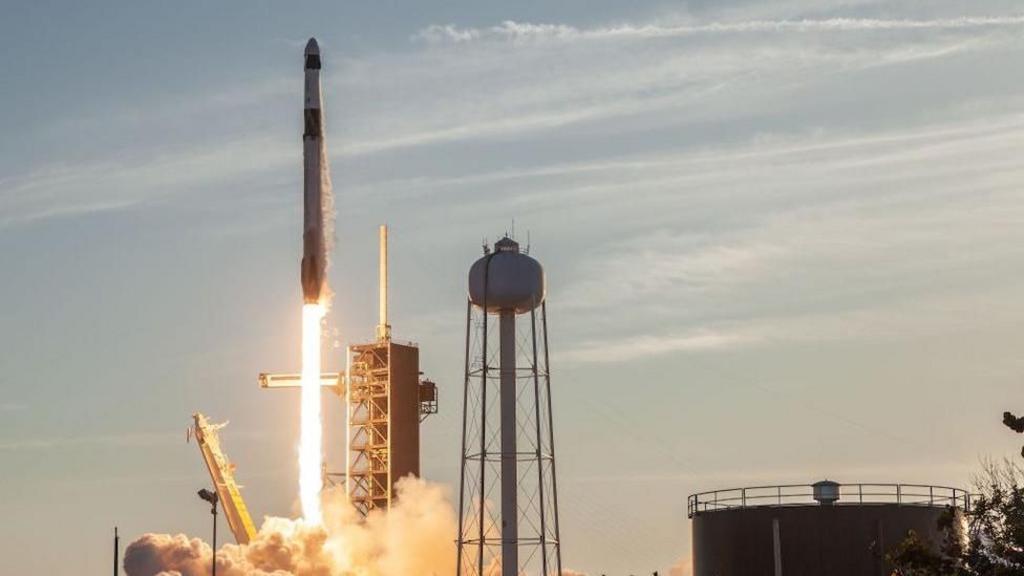A dispute between Donald Trump and Elon Musk regarding a significant spending bill has intensified uncertainty surrounding NASA’s budget, which faces substantial cuts.
NASA’s budget request to Congress proposes a nearly 50% reduction in funding for science projects.
This could lead to the termination of 40 science missions currently underway or already in space.
The President has threatened to terminate federal contracts with Musk’s SpaceX, a crucial partner for NASA in resupplying the International Space Station and future lunar and Martian missions using its Falcon 9 and Starship rockets.
Dr. Simeon Barber, a space scientist at the Open University, describes the uncertainty as having a “chilling impact” on the human space program.
“The recent dramatic exchanges and abrupt policy shifts undermine the foundational elements upon which our ambitions are built,” he states.
“Space science and exploration depend on long-term planning and collaboration between governments, corporations, and academic institutions.”
Beyond the Trump-Musk conflict, deep White House-requested cuts to NASA’s budget are also a major concern.
All sectors face potential budget reductions, except for the Mars exploration initiative, which received a $100 million (£74 million) increase.
Casey Dreier, chief of space policy at the Planetary Society, calls the proposed cuts “the biggest crisis ever to face the US space program.”
NASA justifies its request for a nearly 25% budget reduction by stating that it aligns “science and technology portfolios to missions essential for the exploration of the Moon and Mars.”
Dr. Adam Baker, a space analyst at Cranfield University, told BBC News that Congressional approval of these proposals would fundamentally shift NASA’s focus.
“President Trump is refocusing NASA on two goals: landing astronauts on the Moon before China and planting a US flag on Mars. Everything else is secondary.”
Proponents argue the White House budget provides NASA with a clear objective for the first time since the Apollo era, echoing the Cold War competition with the Soviet Union. Critics, however, contend that NASA has become an unwieldy, unfocused bureaucracy with a history of significant cost overruns and wasteful spending.
The Space Launch System (SLS), NASA’s new Moon rocket, exemplifies this, with its development plagued by delays and exorbitant costs of $4.1 billion (£3.3 billion) per launch. In contrast, SpaceX’s Starship and Blue Origin’s New Glenn aim for significantly lower costs through reusability.
The White House proposals aim to phase out SLS in favor of Starship and New Glenn, despite Starship’s unsuccessful recent test launches and New Glenn’s early testing phase.
“The worry is that NASA may be jumping from the frying pan into the fire,” says Dr. Barber.
“The development of these SLS alternatives is being funded by Elon Musk and Jeff Bezos.
“If they lose interest or require additional funding, Congress will be pressured to provide it,” adds Dr. Barber.
Dr. Barber expresses greater concern over the potential loss of 40 missions dedicated to planetary exploration and Earth observation, many involving international collaborations.
“It’s disheartening that years of work can be so swiftly dismantled without a plan for rebuilding.”
These cuts include dozens of existing planetary missions, many already launched with development costs largely covered, along with minimal proposed operating cost savings.
Also jeopardized are two collaborations with the European Space Agency (ESA): the Mars sample return mission and the Rosalind Franklin rover mission.
Professor Sir Martin Sweeting, head of Surrey Satellite Technology Ltd. and co-author of a Royal Society report on the future of space, while expressing concern, suggests a potential upside for Europe’s increased space exploration autonomy.
“Perhaps we’ve over-relied on NASA,” he told BBC News.
“This presents an opportunity for Europe to reassess its space activities.”
However, the short-term consequences for Europe are largely negative. Besides the Mars missions, ESA risks reduced access to the ISS and the cancellation of NASA’s contributions to the Lunar Gateway.
ESA’s recently published strategy indicates its intention to develop a more independent space program while remaining a collaborative partner, implying continued engagement regardless of NASA’s actions.
Numerous Earth observation programs are also facing cuts, according to Dr. Baker.
“These Earth observation programs are our early warning system,” he told BBC News.
“Our ability to predict and mitigate the impact of climate change could be severely hampered. Shutting down this system is a frightening prospect.”
The budget proposals await Congressional approval. Casey Dreier reports that some Republicans have privately indicated opposition to the cuts.
However, Mr. Dreier expresses concern that political gridlock could result in no budget agreement, leading to the temporary implementation of the reduced White House budget, which may be difficult to reverse given the challenges of restarting terminated space missions.
Scientists are analyzing the scents of space – from the aromas within space stations to planets light-years away – to understand the universe’s composition.
Researchers in the US and Japan are competing to explain the origins of planets, stars, and galaxies.
Despite space infrastructure’s relatively recent development, some elements have already been lost. “Space archaeologists” are working to preserve what remains.
Major tire companies are testing tires capable of withstanding lunar and Martian conditions.
The UK now possesses the first Moon samples collected in nearly 50 years, loaned by China for the first time.

